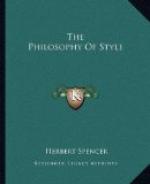iii. Need of Variety.
64. But this extension of the general principle of economy—this further condition to effective composition, that the sensitiveness of the faculties must be continuously husbanded—includes much more than has been yet hinted. It implies not only that certain arrangements and certain juxtapositions of connected ideas are best; but that some modes of dividing and presenting a subject will be more striking than others; and that, too, irrespective of its logical cohesion. It shows why we must progress from the less interesting to the more interesting; and why not only the composition as a whole, but each of its successive portions, should tend towards a climax. At the same time, it forbids long continuity of the same kind of thought, or repeated production of like effects. It warns us against the error committed both by Pope in his poems and by Bacon in his essays—the error, namely, of constantly employing forcible forms of expression: and it points out that as the easiest posture by and by becomes fatiguing, and is with pleasure exchanged for one less easy, so, the most perfectly-constructed sentences will soon weary, and relief will be given by using those of an inferior kind.
65. Further, we may infer from it not only that we should avoid generally combining our words in one manner, however good, or working out our figures and illustrations in one way, however telling; but that we should avoid anything like uniform adherence, even to the wider conditions of effect. We should not make every section of our subject progress in interest; we should not always rise to a climax. As we saw that, in single sentences, it is but rarely allowable to fulfill all the conditions to strength; so, in the larger sections of a composition we must not often conform entirely to the law indicated. We must subordinate the component effect to the total effect.
66. In deciding how practically to carry out the principles of artistic composition, we may derive help by bearing in mind a fact already pointed out—the fitness of certain verbal arrangements for certain kinds of thought. That constant variety in the mode of presenting ideas which the theory demands, will in a great degree result from a skilful adaptation of the form to the matter. We saw how the direct or inverted sentence is spontaneously used by excited people; and how their language is also characterized by figures of speech and by extreme brevity. Hence these may with advantage predominate in emotional passages; and may increase as the emotion rises. On the other hand, for complex ideas, the indirect sentence seems the best vehicle. In conversation, the excitement produced by the near approach to a desired conclusion, will often show itself in a series of short, sharp sentences; while, in impressing a view already enunciated, we generally make our periods voluminous by piling thought upon thought. These natural modes of procedure may serve as guides in writing. Keen observation and skilful analysis would, in like manner, detect further peculiarities of expression produced by other attitudes of mind; and by paying due attention to all such traits, a writer possessed of sufficient versatility might make some approach to a completely-organized work.




